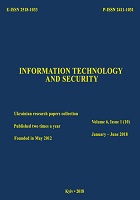Quasi-hierarchical social network nodes ranking in terms of logarithmic function of its link weights
DOI:
https://doi.org/10.20535/2411-1031.2018.6.1.152899Keywords:
Quasi-hierarchical networks of social nature, network subject, ranking algorithm, HITS algorithm, PageRank algorithm, nodes ranking, F-measure, expert evaluation, Zipf lawAbstract
Networks of social nature are the basis of all interactions between participants (usually people) that occur in the process of transferring information between them. Recently, the use of such networks is gaining in popularity. According to expert estimates in these networks, it is possible to get a lot of valuable information about their participants: from personal data (place of residence, contact number, e-mail address) to behavior and assessment of flavors. When evaluating a social networks, graphs representing the real interaction of nodes in such networks are represented. For evaluation, it is necessary to rotate the nodes, to conduct their detailed analysis, to evaluate the results obtained according to all the given criteria and to allocate among them the most influential. Existing algorithms for ranking in the overwhelming majority are estimated only by hierarchical networks, which does not allow to clearly determine the influence of nodes among themselves. The large number of links between nodes in social networks and their diverse distribution in most cases does not allow for the use of algorithms ranking the basic form, because the ignoring of minor, at first glance, linkages leads to false results. The paper analyzes the ranking of nodes and compares the results of the known algorithms for ranking the nodes HITS, PageRank with expert evaluation of the network. For the efficiency of the quasi-hierarchical networks research, the basic HITS algorithm was modified, which allows to analyze and rank nodes according to the given criteria (the number of input and output links among themselves). This is consistent with the results of expert evaluation. It is shown that due to the use of the modified algorithm results are obtained that correspond to real social connections between the subjects, and the indexes of the authorship of the nodes - to the previously provided social roles. The resulting algorithm allows you to evaluate and identify the most significant nodes in social networks and can be used in various industries where social networks are formed.
References
D. V. Lande, and A. O. Nechaev, “Algorithm for ranking of nodes of quasi-hierarchical networks of social character”, Problems of informatization and management, vol. 1, no. 49, pp. 46-50, 2015. doi: 10.18372/2073-4751.1.8917.
D. Cohen, “All the World’s a Net”, Newscientist, vol. 174, no. 2338, pp. 24-29, 2002.
A. N. Langville, and C. D. Meyer, Google’s PageRank and Beyond: The Science of Search Engine Rankings. Princeton, New Jersey, USA: Princeton university press, 2013.
Y. Y. Liu, J. J. Jean-Jacques Slotine, and A. L. Barabasi, “Control centrality and hierarchical structure in complex networks”, PLOS ONE, vol. 7, no. 9, pp. 1-7, 2012. doi: 10.1371/journal.pone.0044459.
D. V. Lande, A. A. Snarsky, and I. V. Bezsudnov, Internet: Navigation in complex networks: models and algorithm. Moskow, Russia: Librokom, 2009.
O. K. Sulema, and D. V. Lande, “Finding the optimal hierarchy in the quasi-hierarchical graph according to the criteria of centrality”, Registration, storage and processing of data, vol. 17, no. 4, pp. 3-10, 2015.
L. Laura, and Me. Gianluigi, “Searching the Web for illegal content: the anatomy of a semantic search engine”, Soft Computing, vol. 21, iss. 5, pp. 1245-1252, 2017. doi: 10.1007/s00500-015-1857-4.
D. A. Gubanov, and A. G. Chkhartishvili, “Formal and informal communications of users of the social network Facebook”, in XII All-Russia Meeting on the Problems of Management, Moscow, 2014, pp. 6301-6309.
A. G. Dodonov, D. V. Lande, and V. G. Putiatin, Computer networks and analytical studies. Kyiv, Ukraine: IPRI NAS of Ukraine, 2014.
J. Scott, Social network analysis. London, UK: SAGE Publications Ltd, 2017.
M. R. Parks, “Personal relationship and personal networks”, Journal of Communication, vol. 58, iss.2, pp. 397-399, 2008. doi: 10.1111/j.1460-2466.2008.00391_2.x.
S. P. Borgatti, M. G. Everett, and J. C. Johnson, Analyzing Social Networks. London, UK: SAGE Publications Ltd, 2018. – pp. 13-25.
Downloads
Published
How to Cite
Issue
Section
License
Copyright (c) 2020 Collection "Information technology and security"

This work is licensed under a Creative Commons Attribution 4.0 International License.
The authors that are published in this collection, agree to the following terms:
- The authors reserve the right to authorship of their work and pass the collection right of first publication this work is licensed under the Creative Commons Attribution License, which allows others to freely distribute the published work with the obligatory reference to the authors of the original work and the first publication of the work in this collection.
- The authors have the right to conclude an agreement on exclusive distribution of the work in the form in which it was published this anthology (for example, to place the work in a digital repository institution or to publish in the structure of the monograph), provided that references to the first publication of the work in this collection.
- Policy of the journal allows and encourages the placement of authors on the Internet (for example, in storage facilities or on personal web sites) the manuscript of the work, prior to the submission of the manuscript to the editor, and during its editorial processing, as it contributes to productive scientific discussion and positive effect on the efficiency and dynamics of citations of published work (see The Effect of Open Access).

